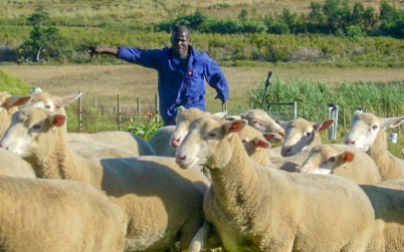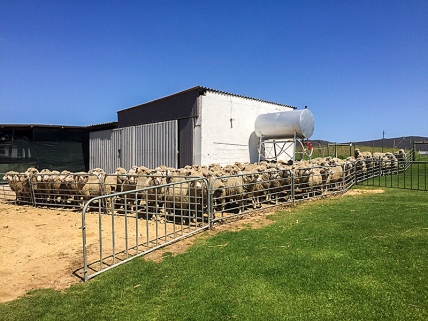Monthly Archives: October 2015
Shearing time again…
Family Fun at Landmeterskop
Heifer-calf on a lead… and new chicks!
The latest addition to our family of animals at Landmeterskop, a heifer-calf, normally hangs out with a flock of lambs and our chickens in the paddock nearest to the farmhouse. When the lambs were brought in to the craal to be weighed, “madam” came along. The workers couldn’t separate her from the lambs, as she simply stayed in the middle of the flock. Eventually Louis managed to get a lead around her neck, and she obediently followed him back to the paddock.
Valerie also recently had to fetch new Leghorn chickens as most of our laying hens are a little over two years old and will now start to lay less eggs. The first 2 years of a hen’s life is her most productive. By the time she’s 5 years old she will only lay half as frequently as she did during her first 2 years. While Louis and Luca were “unloading” the new chicks and making sure that they had food and water and were settling in, Jack and Jesse, kept a close watch!
A letter from Terry
Hi ValerieIt is more than a week since we left the farm or should I say tore ourselves away.To write in the guest book is a great way of expressing the amazing stay we had, but I just wanted to personally thank you.Thank you so much of allowing us to share a part of your piece of paradise. Everything was just so fantastic.Janis (my wife) turned 60 on the day we arrived. She had no idea where we were going, only that I was taking her away for the week. I cannot tell you how excited she became when we entered the main gate and came around to the dam and saw a pair of Blue Cranes doing the dance. That was the start of our incredible stay.We so enjoyed feeding the Lambs, the Ducks and the Alpacas! We felt like kids again! We even drank goats’ milk which was surprisingly nice.Then there is Tsala! What a treasure you have in her. So efficient and friendly – a huge asset you have in her! Wow!We were sad to leave but we have tons of photos to look back on and I mean tons. Janis is an artist so she sees art in just about everything even the dew on the grass so she clicks and clicks away.I hope when we next visit, we will meet. Please give Tsala our regardsWarm RegardsTerryPS I’ve attached a few pics
Pretty, but not at all welcome
The masses of pretty purple-blue flowers one often sees along roads at this time of year – also at Landmeterskop – are in fact a menace, and one that is difficult to get rid of. Paterson’s Curse (Echium plantagineum), also known as Salvation Jane (English); Franklin weed or purple echium, is a Category 1 Declared Weed in terms of the Conservation of Agricultural Resources Act, Act 43 of 1983, which must be removed by landowners as it competes with cultivated crops and pasture species and indigenous ruderal species. (In Afrikaans these are called bloudisseldoring or natterkop.)
Echium plantagineum is native to western and southern Europe (from southern England south to Iberia and east to the Crimea), northern Africa, and southwestern Asia. It has been introduced to Australia, South Africa and United States and is an invasive plant. Due to a high concentration of pyrrolizidine alkaloids in the shoot it is poisonous to grazing livestock, especially those with a simple digestive system like horses. The toxins are cumulative in the liver and death results from too much Paterson’s curse in the diet.
It is a deep-rooted biennial that can grow up to 1m high. The leaves and stems are covered with coarse, white hairs. The stem leaves are long and small and the basal rosette leaves are broad and large with prominent lateral veins. Blue or purple flowers appear from spring to autumn.
























































